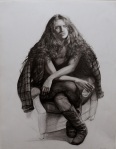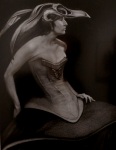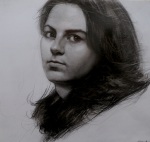An interview with Federico Castelluccio, to whom readers of AAD around the world would recognize in an instant as Furio Giunta on the HBO series, “The Sopranos,” the baseball bat wielding enforcer from Naples who re-established order in Tony Soprano’s house, when he decided the homegrown talent had grown complacent.
In real life, Federico Castelluccio is an extraordinary talented painter, in addition to being a famous actor, director and writer. He came to the USA as a child before developing his art skill to the extent that he attended the prestigious School of Visual Arts in NYC on a full scholarship, where he graduated with honours and with a highest achievement award, in 1986.
Long before he became famous, his art work from that time period had wound up in museums around the USA. The next fifteen years saw him go back and forth between roles in film and being a professional painter before the Sopranos put him once and for all a famous actor, who still paints.
His recent discoveries of previously lost old master paintings propelled him back into the news and it was through our common friend Alexander Boyle, that this interview with a truly remarkable man was arranged.
INTERVIEW WITH FEDERICO CASTELLUCCIO
 Federico at home in New Jersey
Federico at home in New Jersey
EL – I was wondering how you manage to continue with all the aspects of your career which you are expert in, without conflicting one or the other?
FC – Give respect to every single discipline that you are working on, if you do that, and if you don’t do it for any ulterior motive, people will notice that, and they will respect you for that. The passion comes through.
When people get into any kind of business for essentially the wrong reason, they may, for example, have delusions of grandeur in their head, they want to get into acting because they want to become a famous actor. That’s great, but it’s not really the reason one should get into it. They should get into it because of the Art form, the passion and the desire that you have in order to create something special. When we see people, essentially for a part in a film or production, it really doesn’t mater whether we like the actor or not, we look at the skill, the practice of perfection in a performance, the passion.
I’ve had that experience on some of the films I’ve worked on, where I’ve worked with some pretty big names, and you have to be able to navigate these very specific egos that come into your world. So far, I’ve done a pretty good job, and I’m still waiting for that one that’s going be a really tough one.
EL – Tough one? Would you clarify?
FC – Sometimes as a director, you deal with different personalities. Every artist has their own idiosyncrasies that they come in with. And, sometimes, if they are at a certain level, and perhaps they may not have been seen for a while, they can think that they deserve a lot. I’ve dealt with a couple of actors, and I feel that I’ve dealt with them in a very diplomatic way on set, and in the end they were so thankfull that I didn’t do anything that was out of disrespect for them.
I’ve had a situation several years ago on one of my short films where two of the main actors, and they are pretty well known actors, I hired them, and I had no idea that basically they had a beef with each other for years, and it culminated on my set. I was directing and acting at the time, and it was like, what the f**k is going on here man! They literally were coming to fisticuffs, and really going at it. This sparked such an anger in me, that I dealt with it in a very tough way. I said, right, we’re not friggen doing anything you’re suggesting, and both guys sat back down, and that outburst literally diffused the situation, later they made up, and big hugs all round.
EL – As a director, I’m guessing that you have to operate in a similar way to aspects of being a Gallery owner, in that, you are there to advise and mentor, and in essence, metaphorically hold hands with artists on set throughout a film, in order to draw out the best performance.
OK, so let’s get to the questions…
EL – Memories from Naples; was Naples an introduction to Art perhaps? What was it like moving from Naples to Paterson New Jersey, and what inspired the career choice of being an artist?
FC – My family and I left Naples in 1968, I was only three and half years old at the time. Oddly enough, when people ask me that, I do have a very clear memory of Naples, for those three and half years. I was a very visual child, you know, like sensitive to objects and light. I remember knowing the way the light was coming in through windows in each room. I remember also seeing a lot of religious objects and different kinds of paintings and prints in my home when I was a child, and it kind of left an indelible mark in my mind over the years.
I was excited by my brother Antonio, and my sister Inis, who both drew, and I would get very excited by watching them draw.
EL – What, excited at three and half years old?
FC – Yes, I just remember a lot from the three and half years in Naples. I don’t know why, I don’t remember ever being or feeling that excitement with anything else in that time period. Only when I would sit and watch my sister draw and see something come to life on a piece of paper. That was the initial spark, and obviously being quite visual, these things travelled into why I became a painter.
I have to say that the whole experience of Naples and moving to Paterson was really quite traumatic. Moving our entire family, 4 children, my mother, and then my father was not coming, he still had a job and had to raise the money until he was able to come over. At the time there was a law that was passed where relatives could call their family members over like a “call notice”. In Italian it’s called ‘l ‘Atto di Richiamano’, it was a US immigration act, where as immigrants we could gain entry with a written guarantee by a sponsor or a family member, eventually, we were able to get our green card. My grandparents and my aunts and uncles were here already, and others followed from my family.
It was a traumatic time, because we were being uprooted very drastically, and all I remember was a lot of people crying around me, and other family members were crying, and that’s stayed with me.
EL – But it was an essential move at the time?
FC – Yes, yes it was. When we got to Paterson New Jersey, it was very different, the streets were wider, there was a lot of space, and you know, it was right around that time when I started going into school that I realized that people were paying attention to me because of my drawing. I remember being in kindergarten. Actually, I went to a couple of schools, and I didn’t like them, I actually ran away from one of the schools, St.Anthony. I ran away from there because I hated the school, the nuns would pull your hair and stuff, and it wasn’t for me, so I ran away one day, and my mother enrolled me in another school which was St. Stephens, a very nice smaller school, and that’s when I started really kind of noticing that people were getting excited by what I was doing with art.
EL – How old were you then?
FC – I was like, 5 years old, and the teacher, I remember her name, Miss Scullion, she realized that I was more advanced in art, and she gave me water colours to work with. My first painting was a table top still-life with a wine decanter, grapes and bread.
EL – At 5 years old?
FC – Yes.
EL – Your teacher gave you water colours to work on at 5 years old, really?
FC – No no no, I swear, I have people that were in the class with me, that I’m still friends with that can verify that. I absolutely believe that innately I came into this world as an artist. Visually, all of these things that I’m telling you right now are what made me what I am today, as an artist and actor, and even as a director now.
EL – Well hey, I’m sure it wasn’t an easy ride for you.
FC – No it wasn’t, I had a bit of dyslexia, you know, going from one language to the other was tricky, I would read three sentences ahead, and you know, and often I would trip myself up.
EL – Well, some of the most brilliant people in the world have dyslexia, and maybe that’s why the visual language of the Arts appealed to you so much perhaps. Let’s move forward, and talk about the period 1985 – 2000, obviously hitting your mid twenties, how did you get into acting?
FC – OK, even before I decided that this was something I was going to venture into, way before that I was always intrigued by television and theatre. I always had the idea that I would be involved. Somehow I was good with impressions when I was young. I liked to make people laugh, and I made my friends laugh with impressions, and it was kind of cool.
EL – Could that have been a defense mechanism related to the trauma of moving from Naples? Some people do use comedy as a defense mechanism. It’s almost a natural kind of thing to put that barrier there, almost as a barrier to test someone before you let them in closer, as it were.
FC – That’s true, and you have to understand that my first language was Italian, so I had to learn how to speak English while I was in America, going to a new school. So, you know, in those first years, your right, there could have been some kind of defense mechanism there.
EL – OK, so getting into acting…
FC – Every time I would watch a show that had kids in it around my age, I would almost instinctively put myself in that role, and for some reason, I could visualize myself in that role. But the friends around me wouldn’t. When I’d say, hey, wouldn’t you like to play that role? They were like, naah, so I knew that there was something different in my way of thinking back then.
I went to high school, and high school (Passaic County Tech) did not have an acting or theatre program at the time, but it did have a phenomenal art program and that is what I focused on. From there is where I won the scholarship to the School of Visual Arts in NYC, a full four year scholarship.
And now I’m getting to your question.
EL – Take your time, the more you say, the better it is.
FC – So, you asked how did I get into acting, well, in my last year at The School of Visual Arts, I had a friend who was also in illustration and painting classes, and he came over to me and said hey, come check out this theatre group I’m in. I’m gonna be doing a monologue, and I said well, what’s a monologue? And he goes, it’s like a soliloquy, and I said what the f**k is a soliloquy? I didn’t know what the hell it was, my entire world was in painting art and drawing, so you know, this was the first kind of spark into the idea of acting.
So, I went to the class right, and I sat up top, and they had like a little stage area and I watched my friend who I knew very well, and I watched this guy transform into someone completely different, right in front of my eyes. And I was like, this is something I would like to do, this is something I really need to explore further, because it was giving me that same excitement that i’d had when I was kid watching my brother and sister draw. It was at that point, a turning point, which was in my last year at The School of Visual Arts, 1986 I believe, that I decided to explore acting. I got into every possible class, I started devouring books on the subject, getting to know what this subject was all about. Unlike painting, I didn’t have the innate skill, I had to learn how to act, actually, you have to learn how not to act, more than anything. That is really the key to acting, it’s not acting but “being”, and so that was my beginning.
EL – 85 – 2000 – Journey man, artist, actor. How did you juggle these vocations? What, in your mind, took precedent? Was this period a game of survival, and if so, how does that survival game affect an artist’s fluidity?
FC – The real step onto a film set was after I’d graduated from Visual Arts. Now I’m really trying to find the best teachers and everything, and I came home one day, and turned on the TV set to hear the news, and it was towards the end of the segment that they were doing something on a casting director. This casting director was casting for Crocodile Dundee 2, and I just caught the tale end of it. The reporter interviewed the casting director and then it went off, it was CBS news or NBC, one of those news channels. So I called them up, and I asked for Joyce Shank, the lady who was interviewing the casting director, she actually came to the phone, and I said to her that I’d seen a segment that she did yesterday, where she was speaking with a casting director for the film Crocodile Dundee. She goes, oh yeah, his name is Navarro Bertoni, he’s in New York City, you want his number? I said, yeah, so I took his number.
I decided to put a makeshift resume together, because I didn’t have a resume at the time, and I had my friend take a picture. It was a very dramatic black and white picture. It wasn’t a typical head shot, of the type which you might use. It was my idea of a head shot, as I didnt know what one should look like.
Now I’m armed with whatever resume this is, and this head shot. Full disclosure, perhaps the resume wasn’t entirely truthful, but hey, I had to put something on there.
What I wound up doing was arming myself with this, and I was encouraged to go to NYC. There were no cell phones back then, but I had the address of Navarro Bertoni Casting, and there was a pay phone right on the corner of the street where the casting agency was. I called him up, he answered, I heard his voice, and I hung up.
EL – Ouch.
FC – So, okay, I said to myself, I know he’s in there, so to hell with it, I’m just gonna walk in and introduce myself, and I did. I remember a long kind of rail road type of agency. Small, and at the end of the room, was a desk, and there was this guy sitting there with a full kind of roundish face, and he looked up, and he said, “how may I help you”, and this is where the verbal enhancement of my resume, kicked in.
I said, “A friend of mine sent me over, she said i’d be right for the part in y our film Crocodile Dundee 2? “
He said, “Who’s your friend?”
FC – “Joyce Shank.”
NB – “Who’s Joyce Shank?”
FC – “She’s the reporter who interviewed you last night on TV, and she said I’d be good for your film.”
He asks if I have a picture and resume, and I said yes, I give him the picture, and he looks at the picture and then he looks up at me, “It’s dramatic”, as I’m looking around at a wall full of very clear images of actors headshots. Nothing as dramatic as mine.
EL – Have you still got that picture?
FC – Yeah, I have it somewhere.
EL – We don’t have to publish it if you don’t want us to, but we’d love to see it.
FC – OK, I’ve got it some where, I’ll dig it out.
So, he’s looking at my picture and my resume, and he reads my name, Federico Castelluccio, aah, Italiano, so he starts speaking rapid fire Italian with me, and after 5 minutes, we start talking, and I’m thinking this is really cool, I’m clicking with this casting Director and he gets up an one point and he says, in an Italian accent, “ok you come on Toosday, and I putta you in da film.”
I’m like, I thought I was hearing things, and I said, what?
He says again, “you come on Toosday and I putta you in a da film.”
It was a gang scene, and I could see myself in the film. It was as an extra obviously, but the great thing was that I got a chance to get into the film, and I got a chance to understand what it was like to be an extra, standing for hours and hours on end in the rain and wind, and quite frankly, I thought that this was hell. Bertoni came to the set that night and asked me, “So Ow do you like acting” I said I love it! I got a chance to see how things operate on set, and when the film came out, I could see myself in the film, albeit for a few seconds. And not only that, I met Paul Hogan.
EL – You mean Crocodile Dundee, with the corks on his hat?
FC – Yeah that’s right, and I met him and I wound up doing a portrait of him in pencil.
EL – You did a drawing of Paul Hogan from the set of Crocodile Dundee 2?
FC – Yeah, I was a very ambitious guy, and still am, but I was tenacious, and you know, I was like, man I’m gonna get this done. I introduced myself to him, and I just did it. I have a picture of me and Paul Hogan with the drawing I did somewhere.
EL – You have to send that photograph to us.
FC – Oh man, I gotta find these things?
EL – Please find it quick, because I’d like to publish this interview on Columbus Day.
FC – Oh shoot, I’ll try and find it.
What’s funny is that he was interviewed back then, and he said that my drawing was one of the best drawings that had ever been done of him; or something to that effect.
 Paul Hogan & Federico Castelluccio
Paul Hogan & Federico Castelluccio
EL – Moving forward now to 2000 – 2004, on Sopranos. I’m not going to go too deeply into your time as an actor on the Sopranos, I guess you get asked a lot about that. My interest is how the fame that came with being in that show, affected your art? How did it affect your artistic output? Did it slow it down, did you want to be more an actor than artist by then?
FC – What wound up happening was that, being that I was making a living as an artist, doing book covers and illustrating and stuff like that, basically I was making a living off my art, then I added in this other discipline which was acting,
I’d always made a lot of time to study and get into theatre groups. Now I had a background in theatre, and I was with several different theatre companies, in NYC, we did off broadway shows, and then I did regional theatre as well, and really, I was able to do both, paint and act. And when the opportunity came to get into it, I never really called myself an actor until I got my first job, and my first pay cheque. That’s when I said, okay, now I can call myself an actor. Up until that point, I always said I was studying acting.
I kept the two arts very seperate because I noticed that when I told a few people in my family that I was thinking of studying acting, they were alarmed, and they thought I was going to quit painting, and quit the art. I said no-no-no, you don’t understand, they were almost threatened that I was going to give up painting. They knew me as a painter, and I’d studied for all those years going to art school, and they were thinking, going to school and now he’s changing his mind, and I said no-no I’m not changing mind, just adding this other art form to my life. I realized at that point I couldn’t tell people I was an actor, so I kept each art very separate.
EL – I guess that can be a problem, having mastered two forms of the arts can possibly be confusing for people.
FC – Being that I decided to keep things separate, people in the art world knew me as an artist, and people in the acting world knew me as an actor. Neither area had an idea of each other, it was the best way to do it at the time.
When I started getting booked on different TV shows, people started seeing me, so it was hard to keep it a secret, because they started recognizing me. I had always kind of managed to juggle the two careers seperately, but when Sopranos came along, it affected things in a different way. You asked how did acting affect my artistic output? What it did was, the fame actually gave me a forum for more people to know that I’m a painter and see my work. It’s interesting, because now, it seems okay.
People like to circumscribe you into one thing. But as an artist, I think that all arts are related, so as an artist you can explore other avenues, if you feel that is the way you need to go.
EL – In essence, then, you tried to keep both areas completely separate and the fame has shone a light on your art, as opposed to you trying to put that side of your various careers forward. Personally, I think that’s cool, and better that people ‘find out’, as it were, it’s almost a surprise that way.
FC – It’s interesting that you say that, because one of the first times that I realized that there was a tremendous amount of respect for my discipline as a painter, was when I was in a very important acting class in NYC, a lot of famous people came out of that class. The teacher was Molly McCarthy, and people like Matt Dillon and his brother Kevin, Dash Mihok, Heather Graham, and many other great actors came out of that class. I was with a friend and fellow actor at a party after one of the classes, and he mentioned that I was painter to another actor in our class, and I was like, f**k, why did you do that, he showed the actor one of my cards, that has a painting of mine on it, which is now actually in the Yale Museum. So the actor looks at my card, gives this guy my card, and he says, get the f**k outta here, you did this? He was amazed at the painting on my card. I said yeah, that’s one of my paintings, so he started showing everybody else at the party, and I realized at that point, that it was accepted, and it was okay to let people know.
EL – But it’s also, to a certain degree, the fact that you are not ‘selling it’ as it were. I used to use a shipper, and they didn’t have one sales person. They were so efficient and good at what they did, their clients became their sales force, which I’m relating to the fellow who showed your card around. You couldn’t have paid him to do that, it came naturally for that guy, as it does on recommendations.
 The Duke and Duchess of North Caldwell
The Duke and Duchess of North Caldwell
EL – I’d like to move on and touch on a painting which you did for James Gandolfini and Edith Falco, ‘The Duke and Duchess of North Caldwell’. When did that happen?
FC – I painted that piece in 2002, I had taken a trip to Italy in order to work on another episode of the Sopranos, and after that, I took time to travel, and I went to the Uffizi. Ive always wanted to go to the Uffizi in Florence, and I came upon this very famous painting in Art History by Piero della Francesca, called the Duke and Duchess of Urbino, and it was in that split second that I got the impression of the sitters being James Gandolfini and Edie Falco, because here’s the thing, there’s two separate panels in that painting, which reminded me of aspects of the fourth season in The Sopranos.
EL – It’s a dyptych.
FC – Yes it’s a diptych, in other words, there are two separate panels that create one painting. The sitters are looking past each other and that was what gave me the spark and the idea for the painting, because it was around the time that my character Furio Giunta started falling in love with Mrs Soprano, which is Edie Falco’s character, and it ultimately broke up their marrage. And so, here’s this Renaissance painting with this line in between the sitters, and they’re facing each other, but have this 100 yard stare. It was a fleeting thought, and I said to myself, this would make a great painting between Gandolfini and Edie Falco, and it would tie in to the fact that they were separated on the show, and the fact that my character separated them, and I’m the painter; it was just interesting all round, and it was just a thought at the time.
EL – I had wondered if there had been a separation between the two, and thus the diptych.
FC – That’s right, what ultimately happened, was when I was getting on a plane going back to NYC, there was a message from TV Guide, a well known magazine, a national magazine, in the States. And they wanted me to do a painting of the Sopranos cast for one of their covers, and I said, I appreciate this but there is no way I can do that, because in my style, which is realism, it would take me months and months and months to create 14 – 16 portraits of the Soprano cast? So, I declined but I said I have another idea, it was that fleeting thought that I got, when I was in the Uffuzi looking at the painting by Piero della Francesca. TV guide loved the idea, they wrote a feature article and showed a step by step process of how I created the painting. I chose the title, Duke and Duchess of North Caldwell, because that’s where Tony and Carmella Soprano lived in New Jersey. In essence, it’s a trompe l’oeil, because from a distance, people who know the famous painting from Art History say I know that painting, and when they get closer, they’re like, that painting, wait a minute, these are those two known actors, so in essence, my painting is a combination of Pop Culture and Art History.
EL – A lot of your paintings have been created in the Old Master style, not just the Duke and Duchess, although that piece seems more in the medieval style, an Old Masters style seems to be a thread that runs through much of your work. Why, and what’s the pull to paint in that Old Masters style?
FC – I think that once an artist gets inspired, that inspiration finds its way into your work, whether you are an artist, a painter, a sculptor. I think you can get inspired by a teacher, or an object or whatever it is that is surrounding you.
EL – Your style also seems very ‘Italianesque’.
FC – Yeah, the renaissance and baroque period excite me to know end. And that’s why i’m very passionate about them, and what your seeing is that inspiration come through in my work, which is almost paying homage to these great masters. And basically, that was part of my study at school, copying the old masters, that’s what enabled me to really see, and I put quotation marks around “see”, because that is the problem sometimes, some people really don’t “see” art, they just look at it.
EL – Actually, it’s not just seeing art, it’s being able to read art as well. It’s nice to be able to read an artist’s paintings. It gives you insight into their minds and their thinking at the time of painting. I notice with your tromp l’oeils in particular, there’s little messages in there, which obviously mean something?
FC – Absolutely, there’s always a dialogue, and a narrative in my work and it’s good to explain exactly what’s going in that painting. Whether people get it or not, that’s okay, I love to hear peoples interpretations of my work.
EL – People can also take what they want from a painting, everyone will see something different which might be more relevant to them.
I wanted to get to the German Documentary which you’ve been working on. What’s it all about?
FC – Well people from the German Documentary, initially approached me because they read the story that made world news about my discovery of the painting by Guercino. When they interviewed me there was a question which was asked. We were in my studio at the time, they said, how did you discover this, did you know that the painting was by Guercino, or did you find out afterwards? Is this a fluke in other words? I said, absolutely not, Guercino is one of the painters that I studied intensely, and I’m familiar with his studio assistants, his followers, and they don’t even come close. They are great painters in their own right, but his studio assistants and followers, they just don’t come close to the exactness of drawing the human body and the quality of painting that is at Guercino’s level.
And I said, in fact, if you want to know, in a few days there’s a painting that’s coming up in a auction in NYC at Doyles that is wrongly attributed, it’s attributed to a follower of Carlo Marrata, a well known painter from the 17th century in Rome, very famous and in many museums around the world. And I said, but it’s actually by another famous Neapolitan painter Luca Giordano (1634-1705), and I showed them my research, on camera. I went to the two volume monographs that I have on Giordano, and I pointed out that there was another version of this particular painting, showed them the catalogue, and with their own eyes they compared the two. When I saw it in the catalogue, I felt strongly that it was by Giordano, and I knew it was wrongly attributed. I went to the auction house to examine the painting and after seeing it, I was even more convinced, and from there, I went right to the Metropolitan Museum of Art.
There’s a painting of the same subject matter which is the Flight into Egypt, and it’s a subject I really like, and one I didn’t have in my collection, and really wanted. On top of everything, it’s by an incredibly famous 17th century painter from Naples whose work I love, Luca Giordano. And so, I went to the MET, and I examined that painting very carefully, which is a smaller painting than the one in the auction, and it seemed like it was done at around the same period and in the same style as when Luca Giordano was in Spain. I was convinced that it was the same hand and the same painter that did both paintings, so I went back to the auction house, and I have to tell you, I made a big stink.
There was a little sort of puncture in the canvass, and it wasn’t in the picture in the catalogue, and I complained about it, and some people came over and I said you can’t possibly put this in the sale, you have to lower the estimate or something, and they actually took the painting out of the sale.
EL – Did they? Ouch…backfire time…
FC – Yeah, they took it out of the sale, and I asked where are you going with it? They said, well we’re taking it out of the sale and we’re going to fix this tear, and so I got the idea to ask them if they want to sell it outright. I said, would you be interested in doing a private sale, and I’ll fix the tear at my expense. And the lady at the auction house said, well why don’t you send us an e-mail, and we’ll forward it to the owners. So, I wrote a nice e-mail, they forwarded it to the owners, and they came back and said unfortunately, it has to go through auction because it was from a family’s estate, and the attorney that is handling the estate, legally have to do it that way.
This was in October, looking at the positive side, it gave me time to research further. I waited until January, till the new catalogue came out. This time, instead of a small picture in the catalogue like before, there was a huge half page picture. The auction house probably felt that they owed it to the owners for putting a small tear in the canvas and taking it out of the sale in October. Now I’m thinking more people could see this, and possibly identify it.
EL – Ouch.
FC – And it happened that the German guys who were doing the interview with me, were able to get into the auction, and got permission to film while I was there, and to cut a long story short, I actually won the painting on camera, and it is unequivocally by Giordano. I couldn’t have been happier.
EL – Go on then, what did you pay for it?
FC – I paid $9000 plus premium which came out to about 11k, and Luca Giordano’s paintings go for a hell of lot more.
EL – I have to ask, how much is it worth?
FC – Well that depends on a lot of things, on provenance and history, and what similar paintings by Giordano have sold for in the past. I mean it could be a $60 – 80k painting, or even a couple of hundred thousand, who knows. I’ll have to look into it.
EL – So tell me, the Guercino, which has had lots of international coverage indeed, where did you find that painting?
FC – That was in Frankfurt in Germany. I was visiting Yvonne, and her family, it was the first time I went to Germany, and I was actually going to Italy to present a painting to the Chigi Palace Museum, in Ariccia right outside of Rome, and it was a small portrait of one of the Royal members of the Chigi family, which is now in their permanent collection.
 Yvonne Maria Schäfer & Federico Castelluccio
Yvonne Maria Schäfer & Federico Castelluccio
FC – Before going there, I was in Germany, and we went to different museums, we went to the Stadel, different galleries, Yvonne knows I love art and she’s taking me all over the place. She’s driving down this street on the way back, and I said hold on, stop, because there was a gallery there. I thought it was a gallery, but it turned out to be an auction house.
It was closed, the gates were down, and I kind of made my way underneath the gates, and knocked on the door, and the guy came down, and Yvonne said in German, is it okay if we come in, he’s a collector from the States. So they called the manager down, he was very cordial, and he let us in.
He asked what were we interested in, and I said, we’re just looking. Do you have any paintings, and he said yes, you might want to go upstairs, there are some paintings up there. After looking around, there was nothing of interest on the first floor, so we went up to the second floor, and on the landing, there were some paintings stacked up against each other, and I kind of saw the stack out of the corner of my eye, and I thought I’ll come back down here and check those out.
So we carried on upstairs to the second floor, and after seeing that there was nothing of interest there, we went back downstairs. Yvonne went ahead of me. When I caught up with her, she said there’s a Sebastian in the stack of paintings on the landing, and she knows I love Sebastian as a subject matter.
I was planning on looking at them on the way out. So I pulled the two paintings out that were in front of the Sebastian, and it was like a lightening bolt hit me.
It took a split second to realize that I was standing in front of a Masterpiece. It makes you litteraly shake when that happens. The Sebastian was covered with years of old yellowing varnish, and in-painting and over-painting, and there were things about it that were throwing the eye, which might put other people off and distract from the painting being by this artist. Being a collector, for so many years, and seeing paintings being restored, I was able to recognize this as by a Master’s hand, by seeing through all the overpainting and restorations etc. If you’re looking online, or at a photograph of something like this, you really can’t tell, and it may come accross as a much later painting, or even a copy.
So basically, I tried to buy it right off the bat, and he said no, they just signed a consignment form, and it would be in their auction in the next few weeks, and that’s when I started my research. I asked if it would it be alright to find out what it would cost to restore this thing, just so I could come back the next day and take some photos. He said yes, in fact he had a conservator coming the next day, and when he comes, he might be able to tell me what it might cost to fix this, if I were interested in buying it. So we met the next day, I took some photographs of the painting, and spoke to the onsite conservator. It’s turned out that the conservator and I have remained good friends. He was more interested in the frame, and he didn’t recognize the painter either, which was a good thing.
EL – Damn right there.
FC – Yes, quite. I knew that if someone would recognize this painting the way I recognized it, that the price of this painting would go through the roof.
EL – Well, interestingly, this is how some dealers and collectors operate a lot of the time. You can walk round an auction room full of goods, and spot the good thing in a sale relevant to your tastes, a mile off.
FC – Yes that’s right. I mean in order to acquire it, I realized that I could only go up to a certain amount, and that I would have to bring in a partner. The partner whom I called was my business manager, and he said when you come back to the states, I want to see it. So I met him, and I presented my case to him, and he took a leap of faith and decided to do this with me. We got it for something like 49k euros, which was approximately 70k dollars, and by the time we were finished with shipping, restoration costs and all these other expenses, I guess we’ve got about 150k into it, but there’s probably more.
EL – There’s always more expenses involved, and you’ve found a piece of very high value, but more to the point, you’ve re-discovered a lost Masterpiece, backed up with research and paperwork, which not too many people can say they’ve done in a lifetime.
 Federico Castelluccio with Guercino’s Saint Sebastian.
Federico Castelluccio with Guercino’s Saint Sebastian.
EL – Okay, Im going to move on again, and I was going to ask about the Soprano’s again, but you know what, I’m not going to, I’d like to stick with the art, if I may.
FC – Sure.
EL – I’ve been told that you are NBC’s art expert.
FC – Well here’s the thing, I’m very reluctant to call myself an expert because I look at the real experts and they’ve dedicated their entire lives, sometimes to one or two paintings.
EL – That’s very humble of you, but we’ve talked for nearly an hour here, and I feel like I’m speaking with an expert. But listen, I wanted to talk about your source literature, your art history library. What’s that like?
FC – It’s extensive! I have an extensive library of not only different periods on art, but also I have many monographs on artists, and the fact is, that that is the only way to research. I do speak and read Italian, which is an advantage, because a lot of these books have never been translated, that’s why most of the experts can speak and read Italian in order to study and research. In fact, there is an expert in the UK, who is incredibly talented, Nicholas Turner, and he is a gifted expert on Guercino, Caravaggio and others. I do know quite a bit, but the experts spend their lives on these works, and I’m privileged to be constantly learning from them.
EL – What other librarys and Museums do you like?
FC – Besides my own library, there’s the Frick Reference Library and Museum and which is fantastic for research. I can do much more in depth research there, if I’ve exhausted my own source material.
EL – OK, so what’s your favourite museum?
FC – Nostalgically, I have to say the MET and the Frick, because all of my studies were done there when I was at school, but I can’t discount the Capodimonte Museum (In Naples, Italy) because it houses many of my favourite Neopolitan painters in there, including some of the ones I’ve mentioned here.
EL – Getting back to the Guercino just for a moment, and this based on a press release which I read the other day. It was said that the painting hadn’t been on view for 350 years, where was it?
FC – That’s a good question, because in order to find the validity of a painting, where its been, you have to do provenance research, and on the back of the Guercino painting was a very old label, which was marked, Baroness Maltzan, in German. It was a German travel label, so it was being sent by train from Baroness Maltzan to Baroness Maltzan, to a different address.
We believe it was in Poland, and then it went to Munich. We traced it back, approximately 50 years, it was in the collection of a sculptor in Germany, and before that, it was obviously in the Maltzan collection. We don’t know how it got into the Maltzan collection, but we have theories. Prior to that, the only thing we know, is that it was in Guercino’s private home, because at the time of his death in 1666, his biographer, which was the biographer for many painters in Bologna, Count Cesare Malvasia, and he wrote of Guercino’s death, he went to his home and noticed that there were 40 paintings from different time periods in his life which Guercino had kept in his own home and in his possession.
One of them was a Saint Sebastian. Now, many of the experts including David Stone, Nicholas Turner and Luigi Salerno, write that no one could pin point what painting this is. It was in his studio, and the other two half length paintings were accounted for, in what is known as the Libro dei Conte, which was a book of accounts, everything that was sold from 1629 – 1666 was in that book. My painting was not in that book but it was mentioned in the biography, so we’re thinking that this was a painting that he got an idea for, from a very well known alter piece, The Nonantola Alter Piece, and he created my half length St. Sebastian first, after being inspired by the full length St. Sebastian in the Alterpiece in 1632. Then the other two paintings followed, some ten to twenty years later.
EL – You mean almost like a St. Sebastian proto type?
FC – It was a proto type, basically for the other two, but in my opinion and the opinion of other people as well, mine is the more beautiful of the three. But since that time in 1666 we don’t know where it’s been, until we find it in the Maltzan collection. One day I will find that missing part of the puzzle.
EL – That’s fantastic. We have a couple more questions to go through, and then we’re all done, so I wont keep you much longer. How do you approach the crossover between your painting and your film work?
FC – It’s interesting because I never intended to be a director.
EL – Surely it’s a natural career progression?
FC – It is, it is, because there’s a lot of correlation, besides the visual correlation, there’s also a lot of emotional correlation between acting and directing. You are using actors as your implements, the backgrounds the locations are almost like a landscape colour composition. Those are all things that correlate. The reason I never intended to direct, because already I had two disciplines, and the last thing I needed was to add something else to my life.
EL – Yeah right, you love it really!
FC – Yes, that’s true, I do love it.
EL – To quote a well known friend involved in the film industry on your directing, it’s “off the f**king charts”. So here’s the next question. How did you apply your painting skills to the directing and camera work of “Keep your Enemies closer’, what was the methodology, was it planned or did it just flow that way?
FC – When you say, what was the methodology, what do you mean by that?
EL – Relating the question to painting, I’m guessing that you will sit at a canvas and the painting will just flow onto the canvas. Now that you’re behind the camera as well, so to speak, is it the same way, or do you plan for that artistic overlap in your directing?
FC – Are you kidding me? I always plan for everything I do to be off the charts. Whether it turns out that way is a different question.
EL – I can only relate to your work with a paint brush, and I’m sure there are some days that you just sit and paint. It just flows.
FC – Here’s what I try apply to film directing. When I look at myself as a director, and visualize what I want to see, I take a pencil and I draw out each frame, I do my own story boards, which is not an uncommon thing. A lot of directors have done story boards. You know, you look at Fellini who was also an artist, and even Scorsese he does stick figure story boards. There have been many directors over the years that were also painters, and who did their own story boards. That method helps me with my vision, and it also helps the people around me, to understand my vision, like my cinematographer, the set designers, the set dressers, and I tend to do kind of detailed drawings.
EL – Well It’s visual language again, I guess?
FC – Yes it is, it’s all visual language when it comes to Film and Art.
EL – Hey, this is a great interview, and I’m having a great time, so thank you so much for being so fluid, and open with me.
FC – Well hey, I’m loving it too, I told Yvonne yesterday that these are great questions.
EL – Well I did get some help on the film questions, I must confess.
Look, we’re at the last section, and I’m just going to run through these quickly with you.
EL – Since nobody uses chemical film any more, what term do you think best describes film, now that there is digital, what is the high-end term?
FC – We still call it film, it’s not shot on film, it’s digital, but we still call it film. Different terms which are used, are picture, film, movie, but its still essentially classified as a film. Now there’s really no difference in my opinion, the first film that I shot, ‘Tracks of Colour’ was on film,16mm.
My cinematographer for my latest film, and we’ve worked on three films together, was basically reluctant to move into digital film, because he’s been a film guy his entire life. He did many great films, including the original Bad Lieutenant, he did a wonderful film called The Big Night with Stanley Tucci and Tony Shalhoub, and he did about 20 films with Able Ferrara, his name is Ken Kelsh and he was just completely reluctant to move into digital. I said to him that we were shooting the short film ‘Lilly of The Feast’ on digital, because it’s becoming so expensive to shoot on film. He knew that the trend was moving towards digital, and sooner or later he had to go in that direction, and since that time, that’s all he’s worked on, digital. He hasn’t shot one thing in film since.
EL – If it’s okay with you, we’re going to move to the last of the questions, which I’ve called the round up.
What is your favourite piece out of every piece you have ever painted and sold, and why?
FC – That’s an easy question for me, because it was a painting that I did in 1986 and it was a culmination of 4 years of studying painting techniques, colour theory, art history etc. The painting called ‘Fusco Meats’. It’s a portrait of a butcher standing in front of a dilapidated wall with a fading sign that reads Fusco Meats.
EL – Hey, I know that painting, I looked at it, it’s wicked.
FC – I actually sold that painting, it was a very important painting in my ouvre, and it was in my collection, and I decided at one point; you know, as an artist, it’s always feast or famine, and a person was very interested in that painting, a major collector in fact, by the name Richard Brown Baker, he was a major collector of post WW2 art, and towards the end of his life he started collecting contemporary realism. He came across my work through the Knoedler gallery, and through someone that worked with the Knoedler Gallery. He bought two paintings from me, that I actually did in college. One of them was ‘Fusco Meats’, and the other one was ‘Many Happy Returns’, which he bought in the same night. He paid me $30k for both paintings, and it was the biggest sale I had made, at that point in my career. It was an incredible relief for me.
 Federico Castelluccio & Mr. Richard Brown Baker, Patron of the Arts
Federico Castelluccio & Mr. Richard Brown Baker, Patron of the Arts
 ‘Fusco Meats’ (1986) by Federico Castelluccio – Currently in the Yale University Art MusuemAccession Number: 2008.19.118
‘Fusco Meats’ (1986) by Federico Castelluccio – Currently in the Yale University Art MusuemAccession Number: 2008.19.118
EL – Well, money talks doesn’t it? But perhaps, when you’ve made it, as you have, I guess you think, I wish I could have that painting back?
FC – Yes, but here’s the thing, when he passed away, his entire collection was bequeathed to the Yale University Museum and so four of my pieces that were in his collection, including a portrait of him, two portraits in fact, one was a pencil drawing, and one was a large painting, all are in Yale Museum. I’m not sure if they are on display or not, but one thing is for sure, I have the right to first refusal, If they de-accession a painting, I can buy it back.
EL – That’s pretty huge being in the Yale Museum. Before I get to the next three questions, I should like to say congratulations. You must be very proud of your career to date, and Yvonne must be very proud of you as well.

So let’s get to the last couple of questions. Where’s your painting going in the future, we’ve talked about your realism, what’s happening next?
FC – I have so many ideas of different exhibits which I would like to focus on, and one of them is a series of nudes which I’ve been wanting to do for many years. I started some, and I’ve never pursued it further. Other things are a series of Memento Mori focussing on life and death and the brevity of man, which is most likely the next exhibit that I’m going to have in New York City.
EL – When is that?
FC – I was hoping it was going to be this fall, but it looks like it’s going to be next year, maybe some time in the middle of next year. It’s probably going to be a pop up Gallery in NY, that’s my thinking. There’s a lot of these pop up Galleries that are happening, and you know, you can control it more. I do have a gallery that represents my work in New Jersey, and they show and sell my work, but this is something that is going to be very different and more for a NY audience.
EL – So I guess it’s far better to have a niche audience, who are already in appreciation of your work, you can keep it tight that way. What I mean is, is that it must be quite painful to sell an artwork which you’ve spent many many months creating, and if you are going to sell it, (a) you want paid for it, and (b) actually what you are doing in addition to selling a work, is selling passion, in the form of a painting, and you want to know that that passion is in the right hands, and that a client is going to be a custodian of that passion, because otherwise, you won’t f**king sell it.
FC – That’s right, it’s so true man, and that goes back to what I was saying earlier on. If your getting into the business for the wrong reasons, which is fame and money and exposure, it’s really not the right reasons to get into the business. It has to be inside you, in your soul.
There are several galleries who would like to show my work, and there are some unorthodox galleries. I say unorthodox meaning, not your usual Contemporary Art Galleries, but the Old Masters Galleries. I had a show in 2004 called renaissance, it was at the Lawrence Steigrad Fine Arts Gallery, they never had a living artist show there before. They sell Old Master paintings, mainly German and Dutch.
EL – You know something, I feel myself wanting to say congratulations all the time, but I mustn’t keep saying it, because it might sound like I’m trying kiss your ass, but I’m not. I’m thinking, how many great things has this guy done? In fact, prior to this interview, I’m sitting there thinking, how the f**k do I interview someone with so many skill sets?
FC – Here’s the thing man, I’m just another guy, another regular dude.
EL – I hear ya, but that don’t mean I’m listening.
So one last question, then I’m going to love ya, and leave ya.
What can we expect to see from you on the big screen in the near future, and, will you be in front of the camera, or behind the camera?
FC – Both actually. I’m scheduled to be in a film that’s shooting in Brussels in January, called The Toy Gun, and that’s with the famous cinematographer, Blasco Giurato, who did two of my favourite films, Cinema Paradiso and Doctor Zhivago, and it’s going be an incredible experience for me observing him and to see first hand how he works as a cinematographer. That is something I’m really looking forward to in January. Also, I will be directing my next film which has a working title of ‘Where’s Willy’. Right now it’s just a working title, and that’s going to be shot in New Orleans, and New York. I’m looking forward to the first feature film I directed, ‘Lilly of the Feast’ getting distribution, which the producers are working on at the moment. It’s a really good indie film, and I hope a lot of people get the opportunity to see it.
EL – Well hey look, thank you so much for your time, best of luck with all of your various upcoming film projects, we really look forward to seeing you on the big screen in front of, and behind the camera soon, and most definitely, we very much look forward to covering next year’s exhibition of your art works in New York City.
To see a short clip of Federico Castelluccio in The Sopranos, click here.







 Federico at home in New Jersey
Federico at home in New Jersey Paul Hogan & Federico Castelluccio
Paul Hogan & Federico Castelluccio The Duke and Duchess of North Caldwell
The Duke and Duchess of North Caldwell Yvonne Maria Schäfer & Federico Castelluccio
Yvonne Maria Schäfer & Federico Castelluccio Federico Castelluccio with Guercino’s Saint Sebastian.
Federico Castelluccio with Guercino’s Saint Sebastian. Federico Castelluccio & Mr. Richard Brown Baker, Patron of the Arts
Federico Castelluccio & Mr. Richard Brown Baker, Patron of the Arts ‘Fusco Meats’ (1986) by Federico Castelluccio – Currently in the Yale University Art Musuem
‘Fusco Meats’ (1986) by Federico Castelluccio – Currently in the Yale University Art Musuem

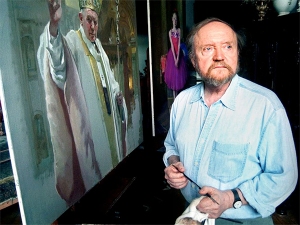

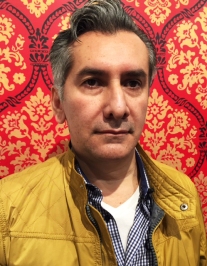

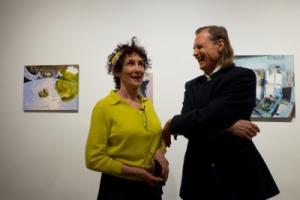
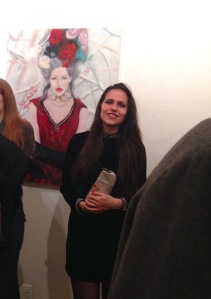
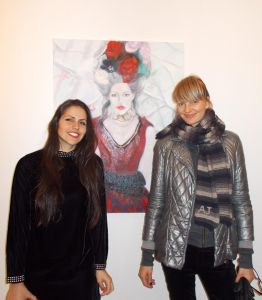
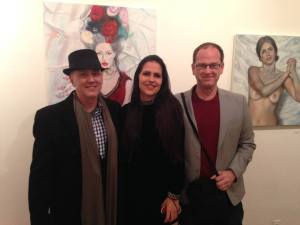
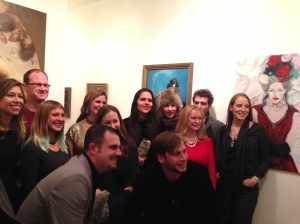


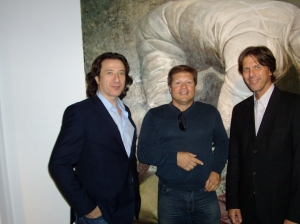 THANK YOU FOR ALL OF THE INSPIRATION…
THANK YOU FOR ALL OF THE INSPIRATION…

































